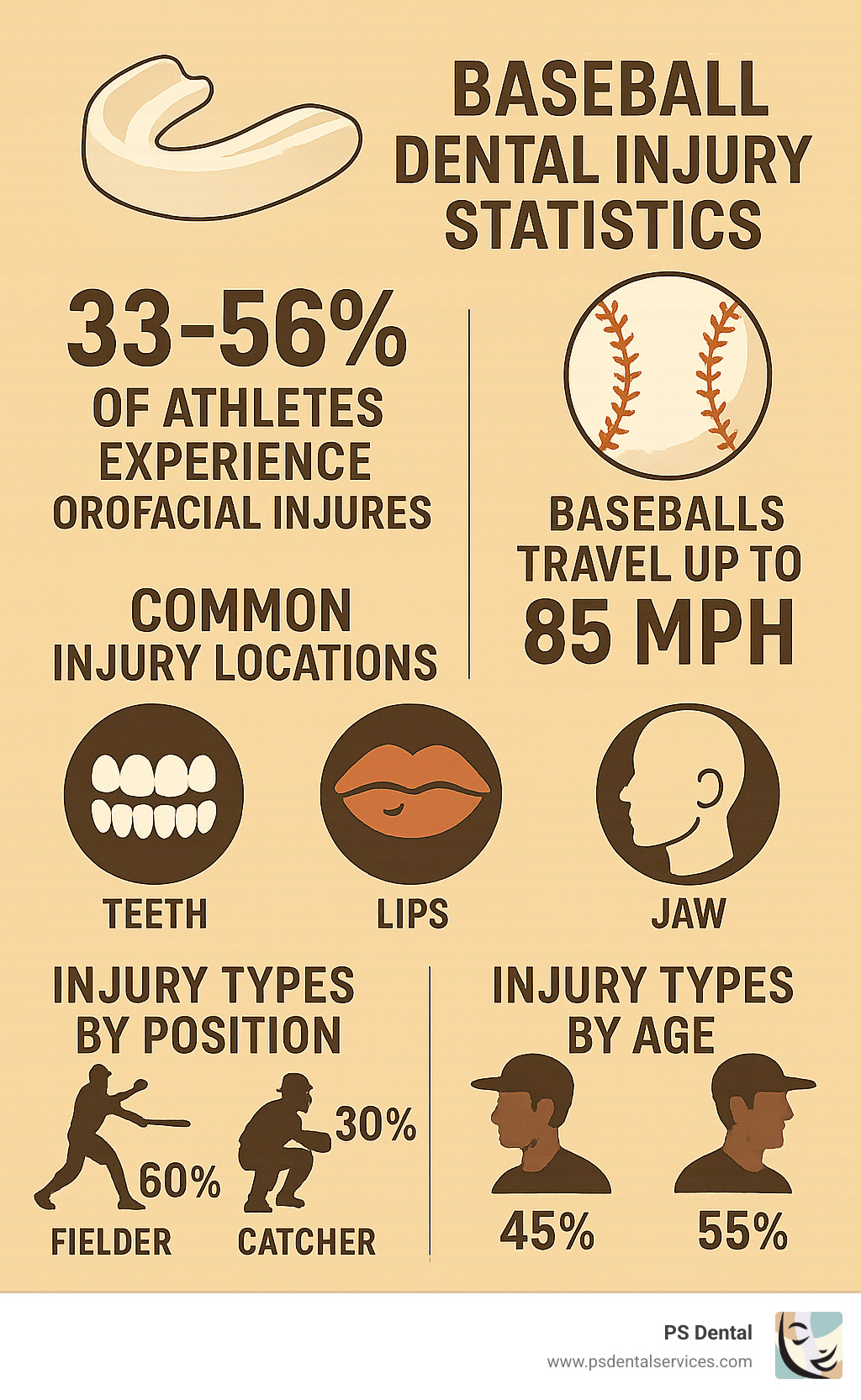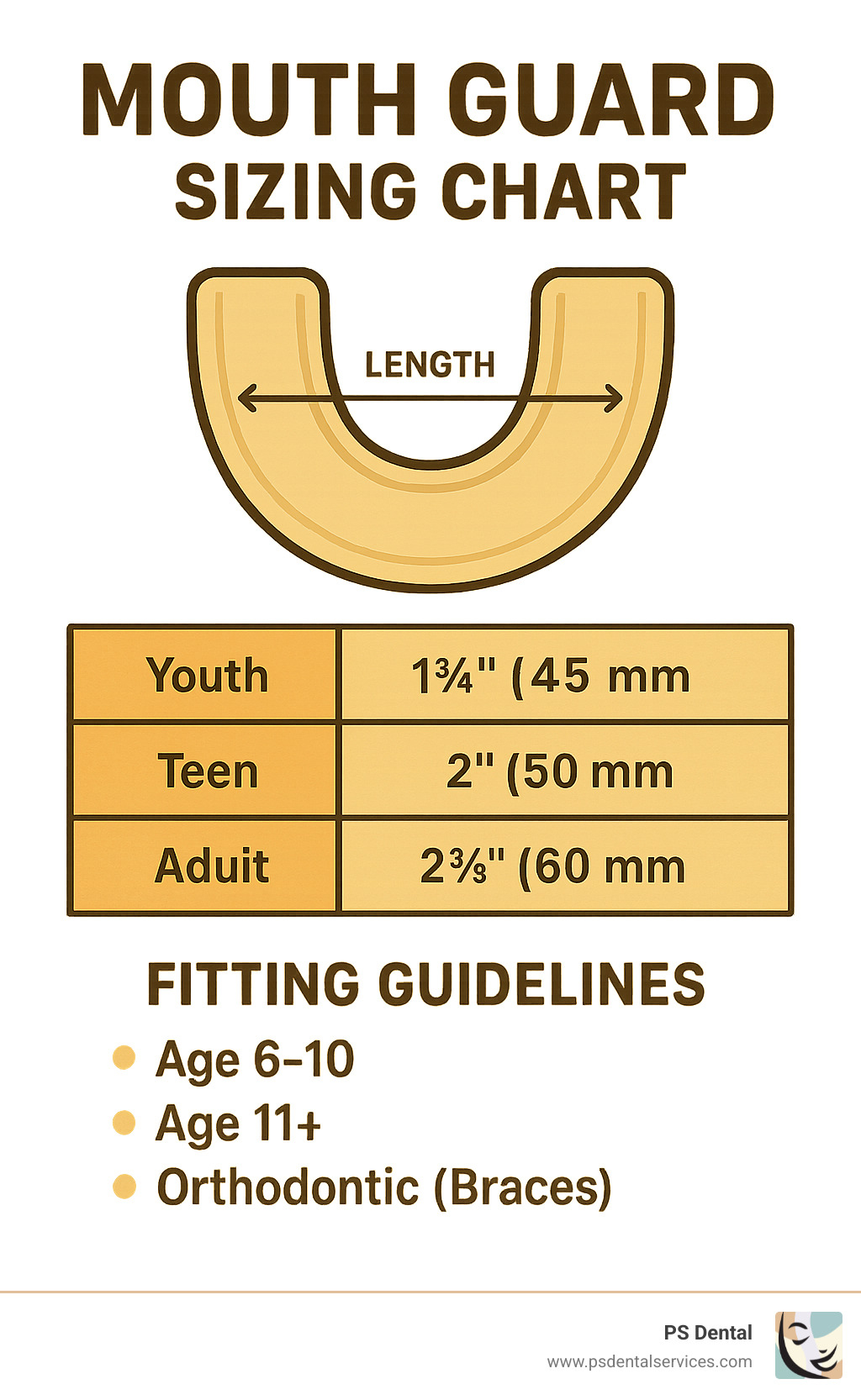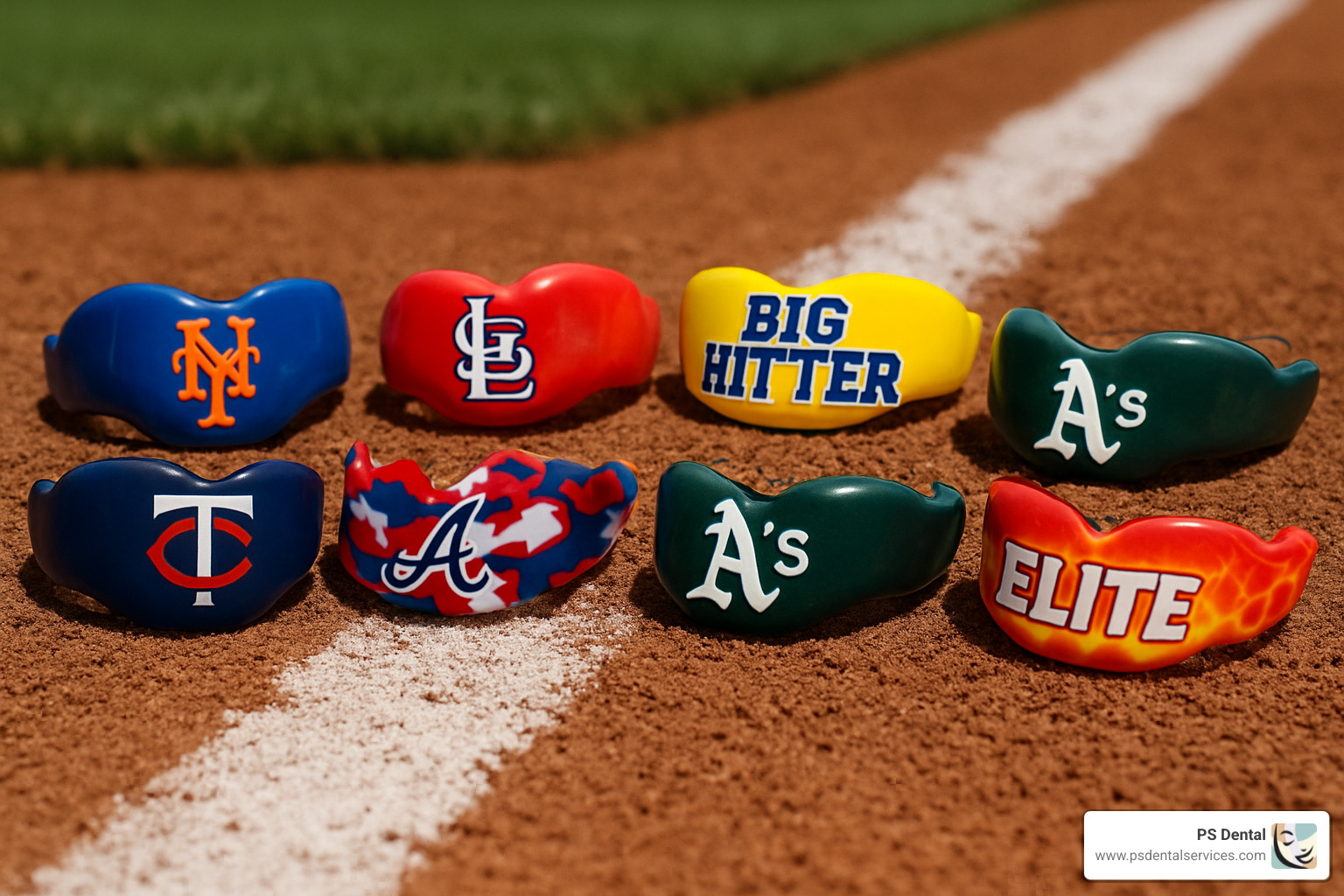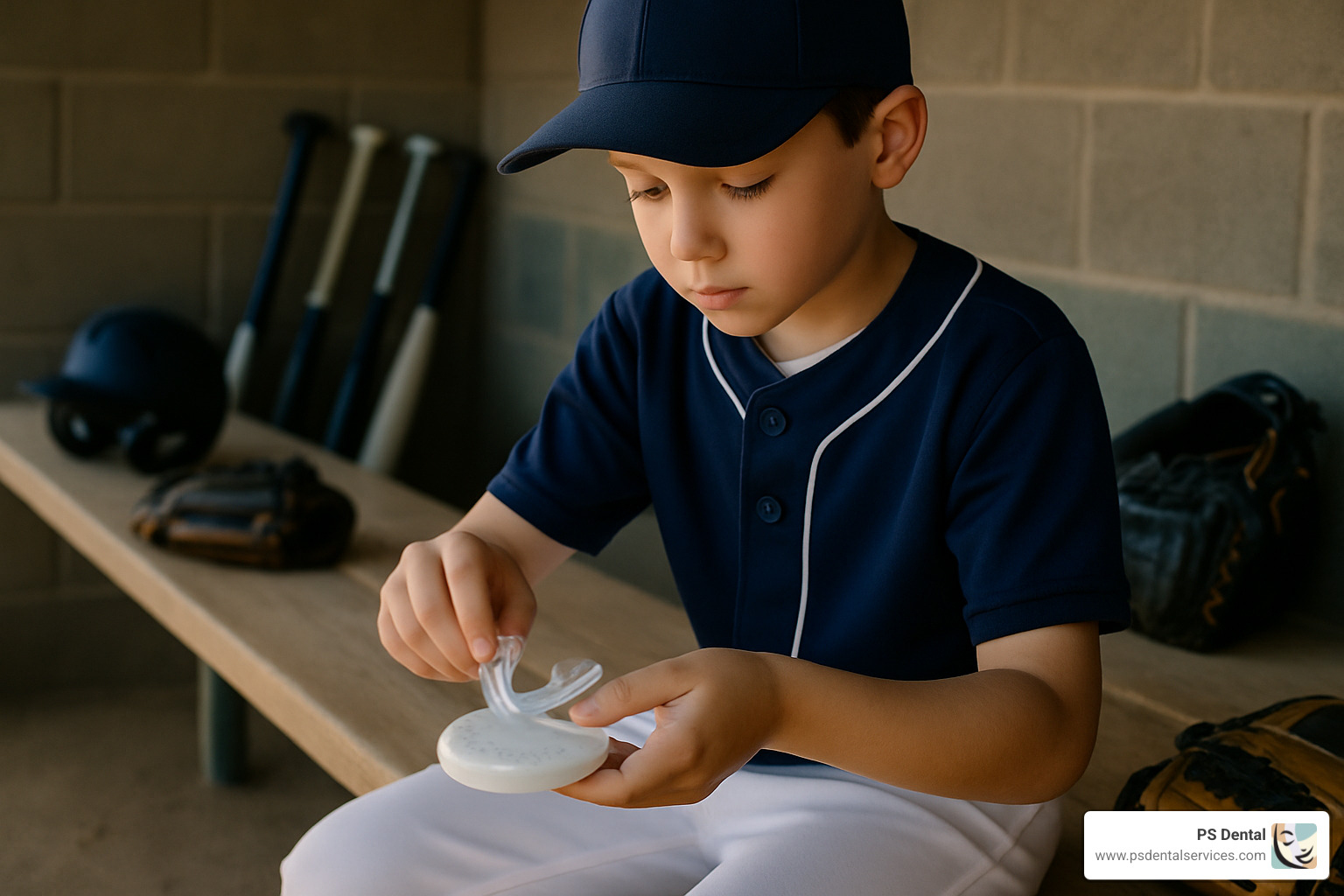Why Baseball Players Need Mouth Guards More Than You Think
A mouth guard for baseball isn’t just for contact sports anymore. While baseball may not seem like a high-risk sport for dental injuries, the reality tells a different story.
Quick Answer for Baseball Mouth Guard Buyers:
– Best Overall: Custom-fit guards from a dentist (most protection, perfect fit)
– Best Value: Boil-and-bite guards like OPRO or Game On ($15-40)
– Budget Option: Stock guards for recreational play ($5-15)
– Youth Players: Look for ADA-accepted guards that accommodate growing teeth
– Players with Braces: Choose guards specifically designed for orthodontic appliances
The numbers don’t lie – athletes have a 33-56% chance of receiving an orofacial injury during their career. When you consider that a baseball can reach speeds of up to 85 miles per hour, the risk becomes crystal clear. Whether it’s a line drive to the infield, a collision at home plate, or a bad hop that catches you off guard, dental injuries happen more often than parents realize.
The good news? Today’s mouth guards are nothing like the bulky, uncomfortable options from years past. Modern designs allow players to breathe easily, communicate clearly, and even drink water without removal.
As Dr. Parisa Sepehri with over 30 years of dental experience, I’ve seen how a quality mouth guard for baseball can prevent costly dental emergencies and protect young smiles. My practice has fitted countless athletes with custom sports guards, and I understand exactly what features matter most for both protection and comfort.
Why Every Player Needs Protection at the Plate
Baseball might look like a safe sport from the stands, but ask any player who’s taken a line drive to the face or been involved in a collision at home plate, and they’ll tell you a different story. The truth is, dental injuries happen more often than most families realize – and they can change a player’s smile (and bank account) forever.
Picture this: You’re playing third base, and a ground ball takes a bad hop off a pebble. In a split second, that innocent baseball becomes a 85-mph projectile heading straight for your mouth. These aren’t rare, freak accidents – they’re part of the game.
The reality check? Research shows that athletes face a 33-56% probability of sustaining an orofacial injury during their playing career. That means if you have two kids playing baseball, odds are at least one of them will experience some type of mouth or face injury before they hang up their cleats.
The most common scenarios include ground balls that take unexpected bounces, collisions during close plays at home plate, and equipment contact during warm-ups. When dental injuries occur, we’re talking about potential jaw fractures, nerve damage that can kill a tooth, years of expensive dental reconstruction, and even concussion mitigation issues when the jaw absorbs impact.
Here’s the good news: modern mouth guards for baseball provide excellent impact absorption. The advanced EVA materials used in today’s guards are specifically engineered to distribute force across the entire surface, dramatically reducing the risk of serious injury. Scientific research on EVA shock absorption shows just how effective these materials can be at protecting athletes.
Performance Perks You Didn’t Expect
A properly fitted mouth guard for baseball can actually make you play better, not just safer. I’ve seen this with the athletes we fit for custom sports guards at PS Dental.
When your jaw is properly aligned with a quality mouth guard, your oxygen intake improves significantly. Many players tell us they feel like they can breathe easier during intense innings, which means better endurance when you need it most.
The jaw alignment benefits are real too. Custom-fit guards help optimize your jaw position, reducing muscle tension and TMJ stress. This is especially helpful for players who tend to clench their jaw during high-pressure at-bats or defensive plays.
There’s also the confidence boost factor. Knowing you’re protected changes how you play. Players wearing mouth guards often feel more comfortable making aggressive diving catches, sliding hard into bases, or crowding the plate during an at-bat.
And unlike those bulky guards from years past, today’s designs allow for communication clarity. Catchers can call plays clearly, infielders can communicate during pop-ups, and coaches can actually understand what everyone is saying.
Choosing the Right Mouth Guard for Baseball
Walking into a sporting goods store can feel overwhelming when you’re trying to pick the perfect mouth guard for baseball. With so many options on the shelves, how do you know which one will actually protect your teeth when that fastball takes an unexpected bounce?
The truth is, not all mouth guards are created equal. After fitting hundreds of athletes with sports guards over the years, I’ve learned that the right choice depends on your budget, how often you play, and what level of protection you need.
There are three main types of guards you’ll encounter. Stock guards are the grab-and-go option that costs about as much as a hot dog at the ballpark. Boil-and-bite guards require a little kitchen time but give you a much better fit. Custom-fit guards are the premium choice that’s made just for your mouth.
Stock vs. Boil-and-Bite vs. Custom-Fit
Stock guards are the most basic option you’ll find. They’re pre-made, ready to wear, and cost between $5-15. While they’re better than nothing, they often feel bulky and loose. Most players find them uncomfortable and end up not wearing them consistently.
The boil-and-bite category is where most baseball players find their home run. These guards start as a blank canvas that you heat up in hot water, then bite into to create your personal fit. At $15-40, they offer serious value for the protection they provide.
What makes boil-and-bite guards special is their ability to mold to your unique bite. The better ones use materials like EVA that become soft when heated but firm up to create a secure, comfortable fit.
Custom-fit guards are the gold standard. Made from precise impressions of your mouth, these guards fit like they were born there. At $100-300, they’re an investment, but they typically last longer and provide the best protection available.
The difference in comfort is remarkable. Custom guards can be made thinner while still providing superior protection because every millimeter is designed specifically for your mouth.
| Type | Cost | Lifespan | Protection Level | Comfort | Best For |
|---|---|---|---|---|---|
| Stock | $5-15 | 1 season | Basic | Poor | Recreational play |
| Boil-and-Bite | $15-40 | 1-2 seasons | Good | Good | Most players |
| Custom-Fit | $100-300 | 2-3 seasons | Excellent | Excellent | Serious athletes |
Special Cases: Braces, Youth & Position-Specific Needs
Players with braces face a double challenge. Not only do they need to protect their teeth from injury, but they also need to protect their mouth from their own braces during impact. A mouth guard for baseball becomes absolutely essential when you have metal in your mouth.
The good news is that modern guards are designed with orthodontic channels that accommodate brackets and wires. Boil-and-bite guards work particularly well for players with braces because they can be remolded after orthodontic adjustments.
More info about Braces Mouth Guard for Sports
Young athletes present their own unique puzzle. Their mouths are constantly changing – baby teeth falling out, permanent teeth coming in, and jaws growing. For youth players, we recommend guards that can accommodate growth and change.
Position-specific needs also play a role in guard selection. Catchers face the highest risk from foul tips and collisions at home plate, so maximum protection is worth the investment. Infielders deal with line drives and bad hops, making a quality guard essential.
Key Features That Knock It Out of the Park
When you’re shopping for a mouth guard for baseball, the difference between a good guard and a great one often comes down to the details. After years of fitting sports guards for players of all ages, I’ve learned which features actually matter on the field.
The best guards today use multi-layer construction that’s honestly pretty impressive from an engineering standpoint. Think of it like a sandwich – the soft inner layer cushions your teeth and gums, while the harder outer shell takes the brunt of any impact. Some premium guards even include shock-absorbing gel layers that can provide 2x the impact absorption of those old-school single-layer guards your coach probably used back in the day.
One feature that players absolutely love is the low-profile design. Modern guards are significantly thinner than what you might remember – some high-performance models are 25% thinner than conventional guards while still offering the same level of protection. This means you can actually breathe normally and your teammates can understand what you’re saying during the game.
Breathability features might sound fancy, but they’re a game-changer. Look for guards with breathing channels or small perforations that keep airflow moving. Trust me, when you’re in the bottom of the ninth and need every bit of oxygen you can get, you’ll appreciate this feature.
Here’s something parents especially appreciate – antimicrobial coatings. Quality guards include treatments that prevent bacterial growth and keep odors at bay. This is particularly helpful with youth players who might not always remember to clean their guard after practice (we’ve all been there).
Customization options have come a long way too. Many guards now offer team colors, logos, or even player names. While it might seem like just for looks, there’s actually a practical benefit – players are much more likely to consistently wear a guard they’re proud of.
Some guards also offer strap options for players who worry about losing their guard during play, and re-moldable materials that let you adjust the fit if it’s not quite right the first time.
Must-Have Checklist Before You Buy
Before you spend your hard-earned money on any mouth guard for baseball, there are some non-negotiables you should look for. Think of this as your protection against buyer’s remorse.
First up is the ADA Acceptance Seal. This isn’t just marketing fluff – it means the American Dental Association has actually tested the guard and verified it meets their safety standards. If you don’t see this seal, keep shopping.
NCAA and NFHS compliance is equally important if your player is in organized sports. These standards ensure the guard will be allowed in games and meets safety requirements for competitive play.
BPA-free materials should be a given, especially for youth players, but it’s worth double-checking. You want medical or dental-grade materials that are safe even if accidentally swallowed.
Look for clear fitting instructions – if the manufacturer can’t explain how to properly fit their guard, that’s a red flag. A good guard should come with step-by-step instructions and maybe even online videos.
A manufacturer warranty or satisfaction guarantee shows the company stands behind their product. If they won’t guarantee it works, why should you trust it to protect your teeth?
Don’t forget the practical stuff either. A ventilated storage case should be included – those plastic containers with air holes prevent bacterial growth and keep the guard from getting gross in your equipment bag.
Finally, make sure there are clear replacement timeline recommendations. A quality manufacturer will tell you exactly when to replace the guard for optimal protection. If they can’t give you that guidance, it might be time to look elsewhere.
The price should make sense for the level of protection offered. While you don’t need to break the bank, a single dental emergency can cost thousands of dollars – making even a premium guard look like a bargain.
Caring for and Replacing Your Mouth Guard for Baseball
Getting the most out of your mouth guard for baseball isn’t just about buying the right one – it’s about taking care of it properly. Think of it like any other piece of athletic equipment: treat it well, and it’ll protect you better and last longer.
Getting the Perfect Fit
If you’ve chosen a boil-and-bite guard, the fitting process is your chance to get it just right. Heat your water to about 180-190°F (just below boiling), then dip the guard in for 10-15 seconds. Use tongs to remove it – trust me, it’s hot! Let it cool for just a couple seconds, then place it in your mouth and bite down firmly for 20-30 seconds.
Once you’ve got a good impression, immediately place the guard in cold water to lock in that custom fit. If there are any rough edges extending past your gum line, carefully trim them with scissors.
Daily Care That Makes a Difference
The best cleaning routine is also the simplest one. Right after each use, give your guard a quick rinse with cool water. At home, brush it gently with a soft toothbrush and mild soap – the same technique you’d use for cleaning your retainer.
Here’s what not to do: never use hot water (it’ll warp the fit), avoid harsh chemicals like bleach, and skip the dishwasher entirely.
Weekly deep cleaning is where you can really extend your guard’s life. Soak it in denture cleaner or an antimicrobial solution for 10-15 minutes, then scrub away any stubborn buildup.
More info about Sports Guard maintenance
Quick DIY Fit & Clean Guide
Knowing When It’s Time for a Replacement
Even with perfect care, every mouth guard has a lifespan. For active baseball players, six months is typically the maximum you should keep the same guard.
Watch for visible cracks or tears – these are safety red flags that mean the guard can no longer protect you properly. If the fit becomes loose enough that the guard moves around in your mouth, it’s time for a new one. Persistent odor that doesn’t go away despite proper cleaning is another sign that bacteria has taken hold.
Storage & Travel Tips for the Dugout
Dugout Best Practices
Game day storage is where a lot of mouth guards meet their end. Always bring your ventilated case to every game and practice. These cases prevent your guard from picking up dirt, getting stepped on, or becoming a chew toy for the team dog.
Between innings, give your guard a quick rinse if possible. Never place it on dirty surfaces or wrap it in a towel where bacteria can thrive.
Travel Smart for Tournaments
Multi-day tournaments present their own challenges. Pack your guard in a hard case to prevent damage during transport, and never leave it in hot vehicles where it can warp.
Frequently Asked Questions about Baseball Mouth Guards
Are mouth guards mandatory in Little League or high-school play?
Most baseball leagues don’t actually require mouth guards yet, which honestly surprises me given what we know about injury rates. Unlike football or hockey where protection is mandatory, baseball has been slower to catch up with the science.
That said, things are starting to change. Some youth leagues are beginning to require mouth guards for baseball, especially for younger age groups where kids are still learning proper defensive techniques.
But here’s my take as a dentist who’s seen too many preventable injuries: don’t wait for the league to make it mandatory. With that 33-56% injury probability hanging over every player’s career, wearing a mouth guard just makes sense.
Will a mouth guard affect my breathing, speaking, or drinking?
I get this question from almost every parent and player who walks into our office. The fear is totally understandable – we’ve all seen those old-school mouth guards that looked like they belonged in a boxing ring, not on a baseball field.
The good news is that modern mouth guards are completely different animals. A properly fitted mouth guard for baseball should barely affect your breathing at all. In fact, some of our patients tell us they actually breathe better because the guard helps align their jaw properly.
Speaking does take a little getting used to – I won’t sugarcoat that. But we’re talking days, not weeks. Catchers especially adapt quickly because they need to communicate constantly.
As for drinking, many players can actually sip water without removing their guard, though some prefer to take it out for longer hydration breaks.
How often should I replace my mouth guard for baseball?
This is where I see a lot of families trying to stretch their dollar, and I totally get it. But think of your mouth guard like running shoes – they wear out with use, and worn-out protection isn’t really protection at all.
For players who are on the field regularly, we recommend replacing guards every six months during the active season. Weekend warriors and recreational players can usually get away with annual replacement. Growing kids are a different story entirely – their mouths change so quickly that we often recommend new guards every 3-4 months.
Players with braces need to be especially vigilant. Every time those braces get adjusted, the fit of your mouth guard changes.
Here’s what to watch for that means immediate replacement time: visible cracks or tears, a loose fit that lets the guard move around, persistent smell even after proper cleaning, or rough spots that irritate your gums.
Replacing a $25 mouth guard every six months costs you about $50 a year. Compare that to the thousands of dollars it can cost to repair or replace a damaged tooth, and suddenly that replacement schedule looks pretty reasonable.
Conclusion
Your smile deserves the same protection as any other part of your body when you step onto the baseball field. The statistics don’t lie – athletes face a 33-56% chance of orofacial injury during their careers, and with baseballs rocketing toward players at speeds up to 85 mph, dental emergencies are far more common than most families realize.
The good news is that today’s mouth guards for baseball are nothing like the bulky, uncomfortable options that gave sports guards a bad reputation. Modern designs allow players to breathe easily, communicate clearly with teammates, and even drink water without removal. Whether you’re looking at a practical boil-and-bite option for your Little Leaguer or considering a custom-fitted guard for serious competition, there’s a solution that fits both your needs and your budget.
What matters most isn’t necessarily choosing the most expensive option – it’s finding a guard that fits properly, feels comfortable, and actually gets worn during every practice and game. The best mouth guard is the one that’s in your mouth when you need it most.
As a dental professional with over 30 years of experience, I’ve unfortunately seen too many preventable dental injuries walk through our doors at PS Dental Services. Cracked teeth, knocked-out molars, and lip lacerations that could have been completely avoided with proper protection. That’s exactly why our team is so passionate about educating families about sports safety and providing custom sports guards that offer maximum protection without sacrificing comfort.
Your teeth are designed to last your entire lifetime – don’t let one unlucky play change that. Whether you’re a parent watching your child take their first swings or a high school athlete with college aspirations, investing in proper dental protection is one of the smartest decisions you can make for your long-term oral health.
More info about Sport-Guard solutions
Dr. Parisa Sepehri
Latest posts by Dr. Parisa Sepehri (see all)
- Mastering Dental Checkups: The Ultimate Guide to Cavity Treatment and General Dentistry for Preventive Care - September 15, 2025
- Transform Your Smile: The Top Benefits of a Hollywood Smile Makeover - September 14, 2025
- Unlocking the Power of Oral Appliance Therapy: A CPAP Alternative for Obstructive Sleep Apnea - September 13, 2025
- Unlocking the Benefits of Inpatient Dental Care: Special Needs Dentistry, Hospital Dentistry, and More! - September 12, 2025
- Revolutionizing Tooth Restoration: The Power of CEREC Crowns in Digital Dentistry - September 11, 2025








